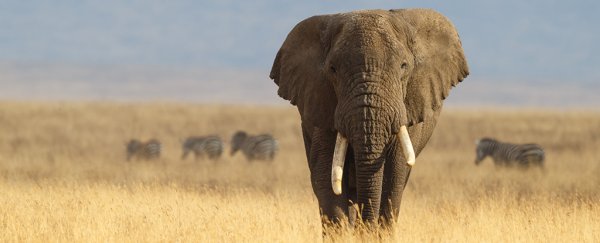For years, scientists have tried to figure out why elephants are so good at not getting cancer. New research suggests their amazing ability involves resurrecting a gene from the dead and giving it a task to kill cells.
Experiments conducted by researchers from the University of Chicago have finally unveiled the mechanism behind the pachyderm's uncanny ability to avoid tumours, helping us better understand a riddle known as Peto's paradox.
It goes like this: the more cells an animal has, the more opportunities it should have to develop a tumour.
Within any given species, this appears to ring true. Larger breeds of dog seem to have a greater predisposition to cancer than smaller ones, for example.
But when comparing animals of different species, the concept falls down. There is zero correlation between the volume of an animal's body or its relative lifespan and the chance of cancer popping up among all those cells.
Named after epidemiologist Richard Peto, the paradox has confused biologists for decades. Clearly evolving to be bigger has meant finding more efficient ways to make sure cancer didn't also take advantage.
Elephants are a textbook example. In 2015, researchers estimated their cancer mortality rate stood at just under 5 percent, compared with the 11 to 25 percent for the relatively puny human body.
That study also found a potential clue to the elephant's anti-cancer superpower in the form of a gene called TP53. Like most anti-cancer genes, it makes a product that detects DNA damage and tells the cell to either fix it or close shop.
Most mammals have two copies of the gene. Elephants have twenty, suggesting they're well prepared to spot the threat of cancer early and act on it at a moment's notice.
Understanding the complex ways such tumour-suppressing genes work in large, long-lived animals isn't easy.
You can breed numerous generations of mice in a lab, but studying cancer in a creature that takes two years to give birth and lives as long as we do required some creative thinking from the researchers.
Geneticist Vincent Lynch and his team took an expedient approach by taking tissue samples from elephants and diminutive relatives such as the manatee and the kitten-sized hyrax, and attacking them with carcinogens that damage cell DNA.
"The elephant cells just died; they were entirely intolerant of DNA damage in a way their relatives' cells were not," says Lynch.
"Because the elephant cells died as soon as their DNA was damaged, there was no risk of them ever becoming cancerous."
There were already hints that TP53 was at work, but there had to be more to the story.
The team had their eyes on another potential candidate described as a leukaemia inhibitory factor, or LIF. The researchers had previously studied the role of this category of gene in pregnancy, so knew it could act as a tumour suppressor.
Oddly, it could also cause cancer under certain circumstances.
Like TP53, there were numerous copies of LIF genes in the elephant's genetic library. It's not unusual for a working gene to have a few dead clones buried under the floorboards, referred to as pseudogenes.
One of those LIF pseudogenes stood out when the elephant cells had their DNA damaged, appearing in substantial amounts.
"We found that elephants and their relatives have many non-functioning copies of the LIF gene," says Lynch.
"But that elephants themselves evolved a way to turn one of these copies, LIF6, back on."
On closer inspection, it seemed LIF6 and TP53 had a close working relationship. Damage to a cell's genetic material draws the attention of TP53, but it turns out that the 'zombie gene' LIF6 is the hired gun.
"This in turn activates the gene LIF6 that can then go to the mitochondria, cause its insides to leak out, and trigger apoptosis, or cell death," says Lynch.
Elephants aren't the only animal to have evolved some odd genetic tricks to stay relatively cancer-free. Other beasties, such as the so-ugly-it's-cute naked mole rat, have their own secrets.
Nature has found a variety of ways to deal with the risks of cells turning rogue. Among them all, there just have to be a few we can steal and apply to our own struggle against the big C.
This research was published in Cell Reports.
